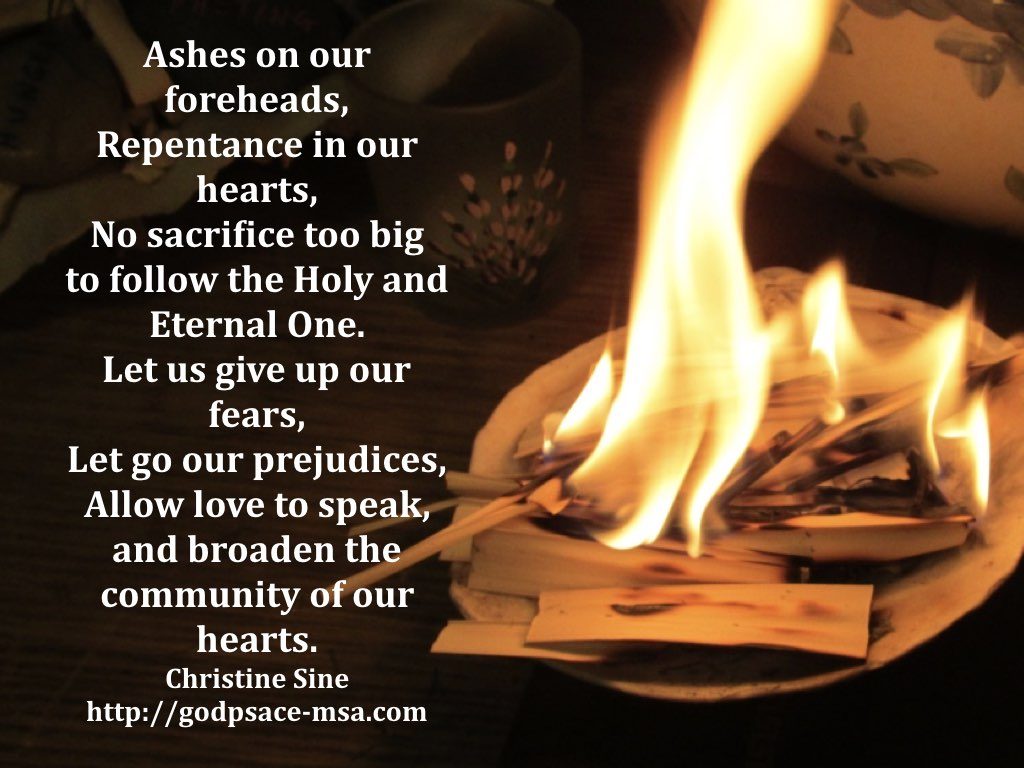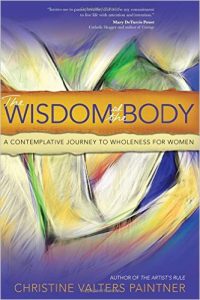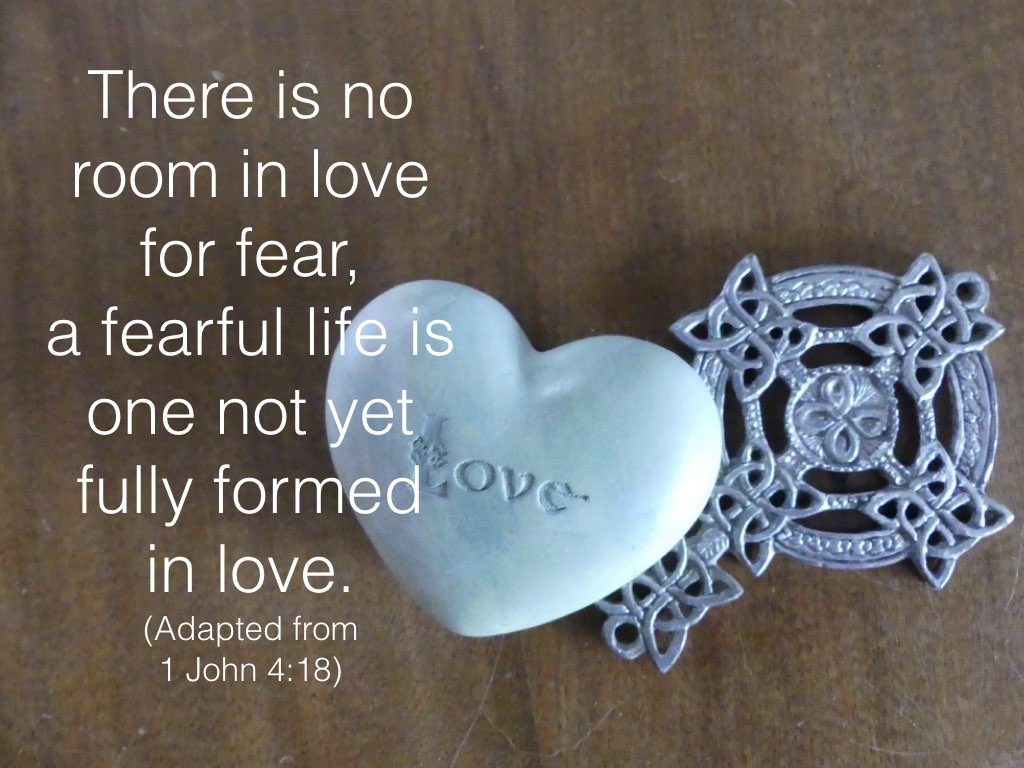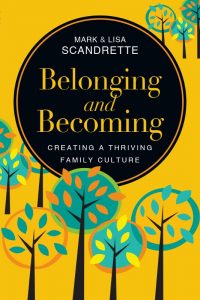“A Lent missed is a year lost from the spiritual life.”
Father Charles Owen Moore
Traditionally Lent is a time of fasting, self-denial, and simplicity, a time set apart for prayer and self-examination, repentance and renewal. It is a call to focus our lives on God’s purposes, to respond fully to God’s initiative, a season whose purpose is to draw us closer to God. Sister Wendy Beckett in her book Sister Wendy’s Meditations on the Mysteries of Our Faith writes:
Lent asks us to scrutinize, calmly and in the presence of God what direction our actions have led us and will lead us. Are we directed toward God? Or toward ourselves? Do we forgive? Do we pray? Do we try to be patient?
Jesus encourages us to focus our lives on God by steeping our “life in God-reality, God-initiative, God-provisions” (Matt. 6:33 Msg).
 One way we steep in God-reality is to set aside time and space for prayer, reflection and to listen to God. Connection to God grounds us in the truth of who God is and who we are. We desperately need this grounding in a culture that is obsessed with self. Often when we look at ourselves it’s as if we’re gazing into a distorted mirror; either we exaggerate our faults and limitations and minimize our good qualities or we are over-confident in our abilities and blind to our limitations.
One way we steep in God-reality is to set aside time and space for prayer, reflection and to listen to God. Connection to God grounds us in the truth of who God is and who we are. We desperately need this grounding in a culture that is obsessed with self. Often when we look at ourselves it’s as if we’re gazing into a distorted mirror; either we exaggerate our faults and limitations and minimize our good qualities or we are over-confident in our abilities and blind to our limitations.
Steeping in God-reality we discover God knows our weakness and shortcomings but also knows our possibilities and potential. This allows us to look at our sin and brokenness remembering the truth of who, and whose, we are. Seeing ourselves in the light of God’s love enables us to move forward holding both our brokenness and our belovedness and to respond to God’s initiative in the present moment more freely and openly.
The image of steeping invites us to give God time and space to deepen our faith and produce fruit that is worthwhile. Many of us live as if a quick dip of a tea bag in lukewarm water is going to produce something worth drinking. Steeping can’t be rushed. Waiting for God’s initiative invites us to let go of working so hard.
Steeping our lives in what God is doing we no longer feel so much pressure to figure everything out and to be superstar Christians. “For we are what he has made us, created in Christ Jesus for good works, which God prepared beforehand to be our way of life” (Eph. 2:10). Knowing that God goes before us Jesus invites us to give our “entire attention to what God is doing right now ”(Matt. 6:34 Msg).
Giving our attention to what God is doing in the present moment we align ourselves with his purposes rather than asking him to join us in what we want to do. Living this way we discover God is already at work and “acts on behalf of those who wait for him” (Isaiah 64.4 Msg). Thus we learn by experience to have confidence in God and can go into our broken, crazy mixed up world and give away what we’ve received firsthand from God—grace, mercy, kindness and love.
Steeping our lives in God’s provision keeps us aware and grateful. It helps us remember who and whose we are. In John 1:3 we read that “everything was created through him; nothing—not one thing! — came into being without him. In Colossians 1:17, Paul reminds us:
We look at this Son and see God’s original purpose in everything created. For everything, absolutely everything, above and below, visible and invisible, rank after rank after rank of angels—everything got started in him and finds its purpose in him. He was there before any of it came into existence and holds it all together right up to this moment.
God has given us life and has even given his only son, Jesus, who gave his life to bring us back into right relationship with God the Father. Steeping our lives in God’s provision allows us to consider and “see how all that is good and every gift descends from on high…as rays descend from the sun, waters from a fountain”.
James 1:17 from the Message puts it this way, “Every desirable and beneficial gift comes out of heaven. The gifts are rivers of light cascading down from the Father of Light.” All the good and beauty we see, know, and experience comes from God’s hand. All holiness on earth is the fragrance of God present in and with us.
One way to steep in God’s provision is to spend time outside seeing the sunlight illuminating creation, feeling its warmth on your body and imagining how God is creating and bathing you in his love. Steeping our lives in God-reality, God-initiative and God-provision encourages us to desire to love God with our whole mind, heart and soul, to become the friend God wants us to be.
May your Lenten journey be a season of renewal and growth as you steep your life in who God is, what he is doing, and the gifts and graces of the present moment.
by Lynne Baab
Why do I find Ash Wednesday so moving? Is it my childhood memories of a smear of ashes on my forehead after going to church on Ash Wednesday? Is it the words that accompanied those ashes? “Remember that you are dust and to dust you shall return.” Maybe I remember the feel of the minister’s thumb on my forehead, making the sign of the cross as he spread the ashes, marking me with my identity as a Christian.
Numerous times as an adult, someone has used oil on my forehead in the sign of the cross, mostly when I have asked for prayer for healing, but as a child the only time I remember that feel of Jesus’ cross on my forehead was Ash Wednesday.
Maybe the whole notion of returning to dust took flight in my mind when I read A Ring of Endless Light by Madeleine L’Engle, my all time favorite L’Engle book. In it, she quotes a prayer from the Episcopal funeral service in the Book of Common Prayer that brings tears to my eyes every time I read it:
You only are immortal, the creator and maker of humankind; and we are mortal, formed of the earth, and to earth shall we return. For so did you ordain when you created me, saying, ‘You are dust, and to dust you shall return.’ All of us go down to the dust; yet even at the grave we make our song: Alleluia, alleluia, alleluia.
When I was an associate pastor serving in a congregation in Seattle, I performed several graveside services, and I always had the sense of standing in a doorway between this world and the next. Those doorway moments enable us to sing our alleluias even as we grieve at the utter devastation of death.
The English word “dust” that we use for Ash Wednesday services is a bit deceptive. The Ash Wednesday words evoke Genesis 2:7, which describes the creation of Adam like this: “The Lord God formed man from the dust of the ground” (NRSV). I looked at 20 translations of that verse, and all but two use “dust.” In English, “dust” sounds dry and lifeless.
The Hebrew word can also be translated clay, loam or earth, and the plural meals “clods of earth.” Obviously dust doesn’t form clods or clump together very well, so the Hebrew word must be referring to the kind of moist earth that clumps together. I’ve been enjoying changing the Ash Wednesday words to: Remember that you are formed of the earth, and to earth you will return.
Because of the life, suffering, death and resurrection of Jesus Christ, the return of our bodies to the earth is not the last word. Jesus overcame death, breaking its power, so that when our bodies return to the earth, we can still sing “alleluia.” As we journey through Lent, we reflect on the awful power of sin and death that brought Jesus to earth. We reflect on what he suffered for us, so that we can say at funeral services and on Ash Wednesday,
All of us go down to the dust; yet even at the grave we make our song: Alleluia, alleluia, alleluia.”

by Christine Sine
I am ready for Ash Wednesday. I always like to start early as a symbol of solidarity with friends in Australia and New Zealand for whom the day has already dawned.
This morning, I burnt the crosses and palms from last year’s Palm Sunday procession as a reminder of Christ’s sacrifice on the Cross. This is the traditional way that ashes are made for the Ash Wednesday celebrations. They are usually mixed with holy water or oil and applied to the forehead in the shape of a cross as a symbol of repentance. People of all traditions now observe this ritual and services are held in churches of all traditions. You can even celebrate on the streets, outside train stations, coffee shops, cinemas or grocery stores, in some places with Ashes to Go, a rapidly growing movement that offers anyone who is interested an opportunity to participate in this ritual and receive a prayer of blessing.
Lent and Easter celebrates the ultimate gift of God’s love. In my Monday Meditation this week, I asked, What am I afraid of? Today, and as I ponder the season of Lent, I wonder how my fears have restricted God’s love from being expressed in my life: What do I need to give up in order for God’s love to be fully realized in my life?
You can check out our entire list of prayers and resources for Ash Wednesday, Lent and Easter here.
Christine Valters Paintner —
Every breath is a resurrection.
—Gregory Orr (excerpt from poem “Concerning the Book that is the Body of the Beloved”)
 In the monastic tradition there is a practice called statio, which is the commitment to stop one thing before beginning another. Imagine, instead of rushing from one appointment to the next, that between each one you pause, you breathe just five long slow breaths. Imagine how this might transform your movement from one activity to another. Or even when you move from one room to another, allow a brief pause on the threshold between spaces. God lives inside our breath and so every breath can become a resurrection.
In the monastic tradition there is a practice called statio, which is the commitment to stop one thing before beginning another. Imagine, instead of rushing from one appointment to the next, that between each one you pause, you breathe just five long slow breaths. Imagine how this might transform your movement from one activity to another. Or even when you move from one room to another, allow a brief pause on the threshold between spaces. God lives inside our breath and so every breath can become a resurrection.
For the Celtic monks, thresholds were sacred places. The space or the moment between – whether physical places or experiences – is a place of possibility. Rather than waiting being a nuisance, or a sense that you are wasting time, it is an invitation to breathe into the now and receive its gifts.
Each moment of the breath is a threshold – the movement from inhale to fullness to exhale to emptiness. The breath can help us stay present to all of the moments of transition in our lives, when we feel tempted to rush breathlessly to the next thing. Instead, what happens in our bodies and hearts when we intentionally pause? When we honor this threshold as sacred? When we breathe deeply and slowly for even a single minute?
Statio calls us to a sense of reverence for slowness and mindfulness. We can open up a space within for God to work. We can become fully conscious of what we are about to do rather than mindlessly starting and completing another task. We call upon the breath as an ancient soul friend to help us to witness our lives unfolding, rather than being carried along until we aren’t sure where our lives are going. We can return again and again to our bodies and their endless wisdom and listen at every threshold.
We often think of these in between times as wasted moments and inconveniences, rather than opportunities to return again and again to the expansiveness of the present moment and the body’s opening to us right now. Our invitation is to awaken to the gifts right here, not the ones we imagine waiting for us beyond the next door.
(excerpted and adapted from The Wisdom of the Body)
Christine Valters Paintner, PhD, REACE is the online Abbess at AbbeyoftheArts.com, a virtual global monastery offering resources in contemplative practice and creative expression. She is the author of ten books including her newest, The Wisdom of the Body: A Contemplative Journey to Wholeness for Women. Christine lives on the wild edges of Ireland with her husband where they lead pilgrimages and retreats.

by Christine Sine
It is still a few days until the beginning of Lent, but I have started early. The hate, anger and animosity I see around me is overwhelming and I think at its heart is fear.
What are we afraid of? This is a question I have reflected on a lot this week as my first step in reflecting on my first theme Let Fear Become Love. I suspect I may not get beyond this first theme for several weeks.
My scripture for the week is 1 John 4:17-18 quoted here from The Message
God is love. When we take up permanent residence in a life of love, we live in God and God lives in us. This way, love has the run of the house, becomes at home and mature in us, so that we’re free of worry on Judgment Day—our standing in the world is identical with Christ’s. There is no room in love for fear. Well-formed love banishes fear. Since fear is crippling, a fearful life—fear of death, fear of judgment—is one not yet fully formed in love.
Why Are We Afraid?
We live in a world filled with fear especially fear of those who are different be it Muslims, people who are LBGTQ, the homeless, people of other ethnicities. Yet most of us are afraid to confront ur fears and do anything about them. Instead we barricade ourselves behind walls of hate and self righteousness.
On a recent trip to Portland my friend Heather shared that she had recently asked this question of her small group. As she pondered her own life she realized that one of her fears was of disabled people. She prayerfully considered what she could do about this and decided to spend time at the local L’Arche community which houses disabled people. When she arrived a woman with Down Syndrome was making a high pitched noise that Heather found alarming. As the evening progressed however, she realized that the woman was laughing. She seemed to be filled with joy and this was her way of expressing it. Her interactions with this woman and others in the community broke down her fear and transformed it into love.
Another member of the group confessed her fear of Muslims. Her response? She visited the local mosque. The Iman was not there but his wife was. The woman enjoyed a wonderful conversation with her over tea and cookies which are always available at the mosque for hospitality. She was able to make an appointment to bring a bigger group back for a visit. Here too her fear was transformed into love.
What is Your Response?
Read through the scripture above and listen to the song below, one of my favourites from John Bell. Prayerfully ask yourself What am I afraid of? Write down the first thing that comes to mind. Think about your fear and the impact it has on your life. Where do you think that fear comes from?
Share your fear and how it makes you feel with a friend.
Read through the scripture again and listen to the song. Now prayerfully, together, ask yourself What would I do if I was not afraid? Listen quietly for God’s response and consider one action you could take in response to your fear that could help you overcome it. Is there a way to reach out to the person or community you are afraid of that shows love rather than fear? You might want to respond as a group and recruit other friends who have similar fears.
This reflection is excerpted from the book, Belonging and Becoming: Creating a Thriving Family Culture, chapter 5, A Thriving Family Fosters Connection.
 At their best, the words family and home represent safety, love and acceptance. Growing up, I was fortunate to experience the reality of these words. There are obviously many factors that contributed to making our home a safe and loving environment, but I think one of the most important was the way we learned to connect and communicate with one another.
At their best, the words family and home represent safety, love and acceptance. Growing up, I was fortunate to experience the reality of these words. There are obviously many factors that contributed to making our home a safe and loving environment, but I think one of the most important was the way we learned to connect and communicate with one another.
For as long as I can remember, there have been practices, rules and rhythms in place that promote communication, conflict resolution and connection in our family. We were taught to use “I feel” statements when addressing issues. We had protocols for processing and resolving conflict. Respect was expected from everyone and went in all directions.
Many of my friends have never had their parents apologize to them for anything or admit that they were wrong. I believe the concern for some parents is that if you admit to your children that you made a mistake, they will lose respect for you. However, ever since I can remember, my parents have been able to admit their errors and apologize for them, and they’ve asked if we feel wronged by them.
I can honestly say that I have a very high respect for my mom and dad because of this. Additionally, their ability to so openly model conflict resolution allowed my brothers and me to imitate it in our interactions with each other until it became second nature.
As with our conflict resolution process, household rules were consistently modeled and explained to us. No rules existed “because I said so.” The time my parents took to explain the reasons behind the rules made me feel respected as an intelligent human who could be trusted to understand the whys and hows and not just the becauses.
Our love and goodwill toward one another was furthered in practice by mutual respect, trust and the tools we were given to address conflict and assert our needs. Affection, however, isn’t solidified through intentional communication alone. Our parents took time to have fun with us on a regular basis. After dinner we’d often play games or music, sing and dance together. Sometimes one of us would be called on to share something we’d created or discovered that was exciting to us.
My brothers and I always got along extremely well. Maybe that’s partly due to luck and complementary personalities, but I think it also had a lot to do with the fact that family fun easily translated into sibling camaraderie. Even now, I’ll watch TV shows with my dad and brothers a couple of nights a week, and my brothers and I seek each other out to joke around and talk on our study breaks.
Our family culture is often hard for me to describe to people who don’t know us well, because it’s this intense blend of openness, mutual respect and understanding, willingness to get into the messy side of being in relationships and an affectionate desire to spend time together.
[themify_button style=”small blue” link=”http://www.markscandrette.com/events/” target=”_blank“]Scandrette Speaking Schedule[/themify_button]
 Hailey Joy Scandrette is Founder and Editor in Chief of Ignighted Magazine, an online magazine and community of people ages 18-30 seeking to follow the teachings and actions of Jesus through incarnational living. She is also the daughter of Mark and Lisa Scandrette, authors of Belonging and Becoming: Creating a Thriving Family Culture. This piece is excerpted from the book (pp. 124-125) in the chapter, “A Thriving Family Fosters Connection”.
Hailey Joy Scandrette is Founder and Editor in Chief of Ignighted Magazine, an online magazine and community of people ages 18-30 seeking to follow the teachings and actions of Jesus through incarnational living. She is also the daughter of Mark and Lisa Scandrette, authors of Belonging and Becoming: Creating a Thriving Family Culture. This piece is excerpted from the book (pp. 124-125) in the chapter, “A Thriving Family Fosters Connection”.

The humble Lenten Rose – not a rose at all but a hellebore – among the earliest flowering plants in the northern garden, often bursting through the dirt and unfurling its petals as the season of Lent approaches. As early as 1400 BCE the non-toxic varieties were used to “cleanse the mind of all perverse habits.”
The season of Lent begins next Wednesday with the celebration of Ash Wednesday. The day before is commonly celebrated as Mardi Gras, or Fat Tuesday, a time of wild excess and celebration before the season of introspection and “giving up”. Originally known as Shrove Tuesday, it was a time to use up the extra fats and sugars in the house before beginning the season of fasting in Lent. It was also a day to make confession for one’s sins before Ash Wednesday.
In the vein of reflection and confession before the beginning of Lent, I invite you to a time of looking more deeply into your life. Instead of listing out your sins, work slowly through the following questions and allow God to reveal the broken areas of your life. These questions are designed to draw out the attitudes and motives that lurk a bit deeper below the surface. Rather than quickly naming off a few obvious sins and moving on, take time to allow the Holy Spirit to guide you into a more comprehensive exploration of your life.
Take a moment right now to examine:
- What habits might be keeping me from loving God more fully?
- What habits might be keeping me from loving my neighbor?
- What habits sap time from my life in an unhealthy way?
- What healthy habits have I developed and how can I continue to nurture them?
Lent is not so much a season of giving up as it is a season of change. We are transformed, and we are continually being transformed. Lent provides us the opportunity to slow down and take a close look into our hearts and minds:
- What do we see?
- Where were we last year at this time?
- How have we grown?
- In what ways have we withdrawn from God and others?
Close your eyes. Breathe slowly and deeply. Listen. Can you hear the Spirit speaking?
Now slowly read this passage aloud. Listen carefully to the words. Read it again. Carry this passage with you today as you continue to reflect on the work of Jesus within you, and give thanks.
Listen carefully: Unless a grain of wheat is buried in the ground, dead to the world, it is never any more than a grain of wheat. But if it is buried, it sprouts and reproduces itself many times over. In the same way, anyone who holds on to life just as it is destroys that life. But if you let it go, reckless in your love, you’ll have it forever, real and eternal. Jn. 12:24 The Message
As an Amazon Associate, I receive a small amount for purchases made through appropriate links.
Thank you for supporting Godspace in this way.
When referencing or quoting Godspace Light, please be sure to include the Author (Christine Sine unless otherwise noted), the Title of the article or resource, the Source link where appropriate, and ©Godspacelight.com. Thank you!
